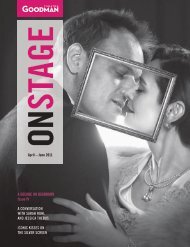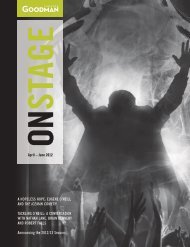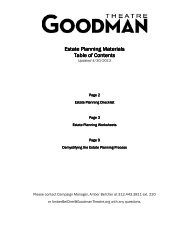The Seagull Study Guide (12MB) - Goodman Theatre
The Seagull Study Guide (12MB) - Goodman Theatre
The Seagull Study Guide (12MB) - Goodman Theatre
Create successful ePaper yourself
Turn your PDF publications into a flip-book with our unique Google optimized e-Paper software.
Medical Advances in 19th Century Russia<br />
BY WILLIAM LANDON<br />
When Chekhov died at the beginning of the 20th<br />
century, some of the most important technological<br />
advancements in Western medicine had begun to<br />
develop. <strong>The</strong>se especially had a huge impact in Russia.<br />
<strong>The</strong> span of Chekhov’s career as a doctor saw changes<br />
in the medical industry that could have influenced<br />
his writing as well as his life outside his role as writer<br />
for the stage and novels- he instilled his work with his<br />
knowledge of objective observation and interest in case<br />
studies. Here are some of those medical advancements,<br />
many of which are still used today:<br />
X-ray technology<br />
<strong>The</strong> medical world in many ways followed a similar path<br />
to theatre at the end of the 19th century: the focus<br />
shifted from the external of the body to the internal,<br />
and medicine became more concerned with the body’s<br />
hidden problems. <strong>The</strong> X-ray photograph was originally<br />
developed in 1895, during toward the end of Chekhov’s<br />
life, by Professor Rontgen at a university in Germany.<br />
This technology was concerned with finding the cause<br />
of hidden pathologies, or injuries and illnesses within<br />
the body. <strong>The</strong> discovery happened almost by accident,<br />
as Rontgen was investigating the properties of<br />
gasses charged by high-voltage electrical currents. He<br />
discovered that the inside of the human body could be<br />
photographed with different levels of transparency. This<br />
advancement helped develop practices in psychology.<br />
Psychology<br />
Up to the late 1800s in Europe and Russia, mental<br />
disorders were greatly misunderstood. Perspectives<br />
changed when doctors and scientists from across the<br />
continent came to the decision that some diseases<br />
were sicknesses of the mind. Charcot articulated it in<br />
this manner: diseases such as “hysteria” left no trace<br />
on the body such as tuberculosis or other physical<br />
diseases would, psychologists decided they must be<br />
mental disorders. Janet, influenced by Charcot’s ideas,<br />
introduced the concept that exceptionally strong ideas<br />
could become permanently implanted, and these ideas<br />
caused psychological disorders. Some, like Freud, took<br />
this idea further and theorized that mental disorders<br />
were produced by psychological rather than physical<br />
trauma to the body. By the 1890s, many psychologists<br />
were of the belief that the unconscious mind held a<br />
deep, often negative, inexpressible reality that only made<br />
itself clear to human thought in an indirect “symbolic<br />
disguise” that had to be analyzed.<br />
26<br />
Medical Clinics<br />
Throughout Chekhov’s lifetime, free medical centers<br />
were set up in provincial areas of Russia. Many of these<br />
were developed in response to the cholera epidemic of<br />
the early 1890s, but the practice began in 1864 when<br />
over 500 were opened across the country. Governmentelected<br />
local doctors, called Zemsky, were paid<br />
somewhat poorly but formed the basis of intelligentsia<br />
medical ideals. Chekhov, who focused often on the<br />
morals of the Zemsky, not only wrote about them but<br />
opened a completely free medical center during the<br />
cholera epidemic. This was a move away from privatized<br />
medicine and toward collectivist medicine.<br />
Antibiotics<br />
We know from references in Chekhov’s plays just how<br />
much modern medicine was used during his lifetime;<br />
aspirin and morphine were used, and are still used today<br />
as painkillers. Antibiotics in the modern sense were not<br />
invented until the late 1920s, shortly after Chekhov’s<br />
death. Still, toward the end of his lifetime it had already<br />
been determined that many diseases were caused by<br />
germs and bacteria acting inside the body. In the 1890s,<br />
two German doctors developed a medication that<br />
could be considered a first prototype antibiotic. It didn’t<br />
always work, but it helped pave the way for Sir Alexander<br />
Fleming’s discovery of Penicillin.<br />
Surgery<br />
Mid – 19th century Russia saw the implementation of<br />
“painless” surgery. This medical concept spread with<br />
the help of universities. University of Moscow’s medical<br />
department, of which Chekhov was a graduate, provided<br />
a link between the medical science of the university<br />
level and the rural Zemstvo social medicine. Moscow<br />
University, at the behest of the Department of Education,<br />
first undertook its study of the use of a chemical called<br />
“ether” for anesthetic in 1847. One of the people who<br />
helped spread the research and experimentation<br />
was Doctor Pirogov, a man often called the father of<br />
modern Russian surgery. He lived through the early<br />
part of Chekhov’s life. He and his contemporaries had<br />
pioneered Russia’s use of chemical anesthetics by the<br />
time Chekhov became a doctor.<br />
Images from left to right: Doctor and surgeon Pirogov; Terapevt<br />
Mudrov hospital train car. Images courtesy of Wikimedia Commons.
















